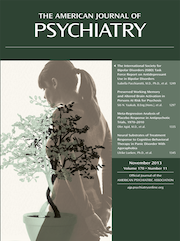T
o the E
ditor: We wish to seek further clarification of the interpretations made in the recently published article by Frank et al. (
1)
The authors state that “the agranular and dysgranular layers [of the gyrus rectus] have fiber connections to the hippocampus, amygdala, cingulate, and insular cortex, areas important for taste as well as reward, motivation, and emotion processing….In line with those functional aspects of the orbitofrontal cortex may be the finding of gyrus rectus volume predicting the rated pleasantness of the sucrose solution.” While a moderate positive correlation was found between gyrus rectus volume and sucrose pleasantness ratings in the healthy comparison group (r=0.419, F=4.970, p<0.03), for all eating disorder groups combined, the relationship was weak at best (r=0.268, F=4.50, p<0.038) and did not hold when individuals with anorexia nervosa, recovered anorexia nervosa, or bulimia nervosa were analyzed separately. How do the authors reconcile that gyrus rectus volume predicts taste pleasantness experience for individuals with eating disorders in the absence of even a moderate correlation between the gyrus rectus and pleasantness ratings?
It was stated that greater gyrus rectus volume in eating disorders may relate to a stronger sensory experience of food stimuli, which may lead to food avoidance (
1). The study did not, however, find a relationship between intensity ratings and gyrus rectus volume, which might otherwise support the hypothesis. The authors reference their previous work showing increased reward and punishment sensitivity in anorexia nervosa relative to healthy comparison subjects (as measured by the sensitivity to reward and punishment scale) (
2) to support the hypothesis that individuals with eating disorders in their study have a greater sensory experience of food stimuli. There were, however, no relationships between reward and punishment sensitivity and brain activation in the previous study. Reward sensitivity reportedly correlated with the putamen for all eating disorders. Thus, how can reward sensitivity (a general measure of sensitivity to reward) linked to the putamen in all eating disorder groups in the Frank et al. study (
1) be reconciled in relation to taste reward or reward and punishment sensitivity that was found in their previous study (
2)?
Finally, given that bulimia nervosa is characterized by uncontrollable bouts of eating, whereas sustained food avoidance is characteristic in anorexia nervosa, how does the model proposed (“greater gyrus rectus volume in eating disorders is associated with stronger sensory experience of food stimuli…which could trigger cognitively driven food avoidance”) account for differences between anorexia nervosa and bulimia nervosa? Perhaps most important, however, is that the described pattern of greater gyrus rectus volume in eating disorders being associated with stronger sensory experiences of food stimuli is the pattern for healthy comparison subjects; hence, the authors should be cautious as to pathologizing the healthy control relationship.

